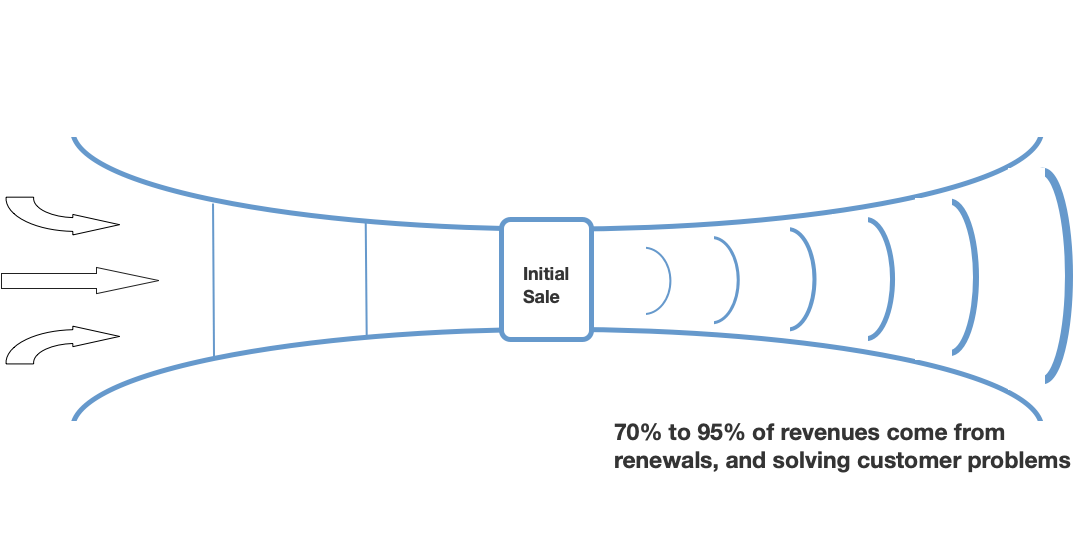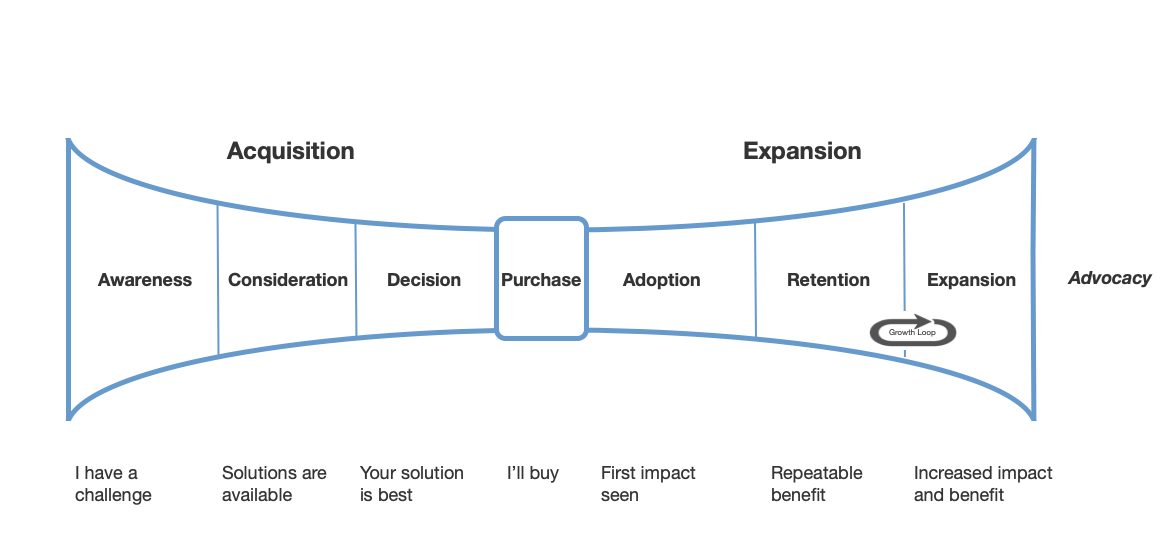Customer Success
Delivering value is central to the purpose of any company. Organisations which continue to deliver value to their customers beyond an initial sale find that those same customers tend to become product experts and loyal brand advocates, and the revenue keeps rolling in.

The primary purpose of every business with a product or service to sell is to build and maintain a base of committed customers who are profitable to the organisation.
The beginning of the relationship
A new Sale signals the beginning, not the end, of the relationship. In sales-centric transaction based companies, the goal is usually to strike a deal and then move on to the next deal. In a customer-centric organisation, the product or service may provide the initial sale, but the value of building ongoing relationships with new customers is that you have the opportunity to listen to their needs and desires. By focusing on providing ongoing solutions, you will be able to develop products that they will want to buy, and be able to do so half-a-step ahead of the competition.
Many SaaS companies now have a dedicated customer success function, because the recurring revenue business model requires continued customer satisfaction in order to keep generating profit. Rather than closing a sale and chalking up another 'win', the seller must work hard to make sure that the new customer actually experiences the benefit that they perceived ahead of their decision to buy, and that they continue to experience positive outcomes.

Ongoing attention
Consider the sales funnel. When turned on its side, the initial customer relationship management continues as customer success management.
Customer success encompasses the ongoing efforts of a business to continue delivering value to its customers. A good customer success capability will deliver value throughout every step of the customer journey, extending the attention given to secure a sale to onboarding, product training, customer service, and support.

This customer journey starts with a potential customer realising that they have a challenge and then the same customer also realising that there are one or more solutions which could meet that challenge. It is important that your marketing ensures that these potential clients know that your company is one of those who could provide that solution. The potential client then chooses which solution best suits their needs, often with the particular help of your sales team.

Once the customer has made the purchase decision then they must be helped to achieve the outcome that they expected. Not only should the product or service that they have bought meet the basic functional need, but it should be delivered in a way that is appropriate to, and pleases, the new customer. Note that the customer experience doesn't have to be 'awesome', but it has to be as appropriate as possible to their needs. This means that it is worth while taking time to understand what the customer sees as their 'critical success factors', and then making sure that you do all that you can to meet them.
How to keep a customer happy
It's critical to have a clear idea of what the appropriate experience is for each customer. Every new customer needs help onboarding and getting the best out of the product that they have just bought. Many companies tailor this attention based on the size of the deal just won, but that is a mistake - every customer needs the 'right level' of attention be happy with their purchase.
Know what your new client's critical success factors are. This should start well before a sale is made, but as well as understanding what the potential client needs to achieve, ask them what good looks like, how they will know when your product has helped them achieve their goals. Ask them about experiences with other vendors that were good, or not so good. The more that you know about what will make your customer pleased, the more that you can delight them.
Make sure that there is continuity across the team who interacted with the new client before they made their purchase decision and into the early days of them adopting your product, helping them really getting to know it and then using it to deliver their first wins. Once they have seen that first impact, then they need to be helped to use your product to get another similar win, and then more and more similar and dissimilar wins. Your customer will want to see that continuity of engagement with the same people.
Put in place an expectation roadmap. Be explicit about what your new customer should expect to do and to achieve in 30, 60 and 90 days. Be clear of what your organisation will do too. Manage expectation and set out the accountabilities of either side. Be sure to also lay out the sunlit-uplands of what the customer's world will look like after each of these 30 day milestones, and signpost that you expect their enthusiasm for the outcomes will make them advocates.
Be ready to intervene as necessary. You need your customer to move from one success milestone to another. If they are doing what they should be doing, then great. If not, then they need some human input to put them on the correct path. Interventions can also be encouragement, or based on your previous experience of what happens after a certain time has passed or a event, such as a change in internal champion, has been triggered.
Keep up a constant level of engagement. New and existing customers will benefit from being part of outreach programmes and information on upcoming product updates. Blogs and invitations to company and industry events will make sure that customers feel part of your company's orbit. Make sure that there is something of interest for your customers to read about on a regular basis.
Help your customer understand their customers. To get the best out of your product or service, your client has to make it work for their customers. You will have some special insight into all the great features of your product, but it is usual for the biggest challenge to be human, not tech. To best help your customer, teach them the same methods to understand their customers in the way that you understand yours.
Measure how well your customer is doing and how well your company is doing. Firstly, your customer: are they making the required progress (hitting outcomes); are they doing what they need to do (meeting their accountabilities to use your product). Secondly, is your customer buying more of your offerings, resulting in an increase in your net revenue (because they are successfully using your products or services).
How to measure customer success
There are many ways to measure customer success. The best ways are outside in, through the viewpoint of the customer rather than bottom line or net repeatable revenue.
Here are three customer success KPIs to start with:
Churn. Every business wins new customers and loses valued customers. Each loss can be taken at face value or used to understand why customers leave. If reasons are known, then action can be taken to prevent further loss, either mitigating action before the loss trigger happens or at the point of loss. Bear in mind that it normally costs far more to win a new customer than keep an existing one, so it can be a prudent decision to spend money to defend a revenue stream.
Net Promoter Score (NPS). NPS is a measure of the sentiment of the extent to which a customer would recommend a product or service. It is an important metric for any business. NPS ranges between −100 (all respondents are detractors) and +100 (every respondent is a promoter). Scores vary across sectors, but a score higher than zero is generally deemed acceptable, 50 or more is excellent, and over 70 is exceptional. The open availability and simplicity of use contribute to the wide use of this metric.
Customer Effort Score (CES). Customer Effort Score (CES) is a simple metric that measures how much effort a customer has to exert to get an issue resolved, a request fulfilled, a product purchased/returned or a question answered. In terms of understanding and fostering customer loyalty, CES has proven particularly useful. CES surveys typically ask the question, “on a scale of ‘very easy’ to ‘very difficult’, how easy was it to interact with [company name]”. CES is one way that a business can measure a customer’s perceived level of ease at various points throughout the customer journey. Loyal customers become brand advocates, product experts, and, most importantly, they renew.
We've not included Customer Satisfaction, which measures the short-term happiness of your customers; it has limited value when it comes to understanding a customer’s ongoing relationship with a company or loyalty.
Organisations which continue to deliver value to their customers beyond an initial sale find that those same customers tend to become product experts and loyal brand advocates.
The biggest barrier to customer success is not making it a key part of the culture.
Customer Success is about a forward looking, long-term mutual relationship and meaningful engagement with the customer, and is an essential part of any successful business.
